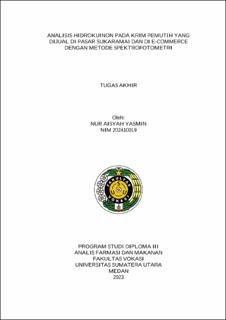Analisis Hidrokuinon pada Krim Pemutih yang Dijual di Pasar Sukaramai dan di E-Commerce dengan Metode Spektrofotometri
Analysis of Hydroquinone in Whitening Cream Sold in Sukaramai Markets and in Ecommerce Using The Ultraviolet Spectrophotometric Method

Date
2023Author
Yasmin, Nur Aisyah
Advisor(s)
Nasution, Lisda Rimayani
Metadata
Show full item recordAbstract
Background: Whitening cream is a type of cosmetic that contains active substances that can suppress or inhibit the formation of melanin, thereby giving the skin a whiter color. Hydroquinone is an active compound that is often added to whitening creams. Hydroquinone is a chemical compound in the form of white, needle-shaped crystals, odorless, with the chemical formula C6H4(OH)2 and the chemical name 1,4-benzendiol or quinol, and undergoes oxidation in light and air. If the whitening cream contains the chemical hydroquinone, it can cause damage to the skin such as irritation, allergies, brain damage, and cancer.
Objective: This research aims to determine whether the levels of hydroquinone in facial whitening cream sold at Sukaramai Market and in e-commerce can be determined using ultraviolet spectrophotometry and in accordance with those determined by BPOM.
Methods: Facial whitening cream samples were purchased at Sukaramai Market and at the e-commerce Shoppe randomly. Next, the samples were tasted qualitatively using color reagents and quantitatively using ultraviolet spectrophotometry at a wavelength of 293 nm.
Results: The results of research on qualitative analysis using FeCl3 and 96 % Ethanol reagents showed that there was one sample, namely sample A, which was positive for containing hydroquinone, where as when using phloroglucin and NaOH reagents there were 5 samples, namely B, C, D, E, F which were positive for containing hydroquinone. From the analysis carried out, the hydroquinone content in sample A was obtained; 0,648 %, B; 0,74 %, C; 0,901 %, D; 1,091 %, E; 1,363 %, and F; 0,907 %.
Conclusion: Based on the results obtained, it shows that the ultraviolet spectrophotometry method can be used to determine hydroquinone levels in whitening cream. The hydroquinone content contained in all samples did not meet the requirements set by BPOM.
Collections
- Diploma Papers [78]
